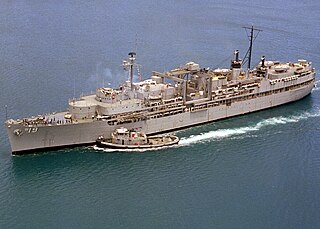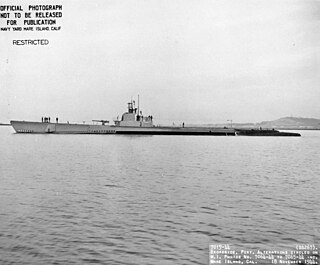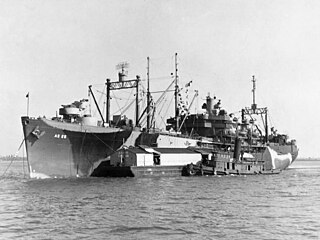
Naval Submarine Base New London is the primary United States Navy East Coast submarine base, also known as the "Home of the Submarine Force." It is located in Groton, Connecticut directly across the Thames River from its namesake city of New London.

USS Bang (SS-385) was a United States Navy Balao-class submarine, named after the bang, a dark blue or black fish of the Atlantic herring family found in the coastal waters of the United States north of North Carolina.

USS Bass (SF-5/SS-164), a Barracuda-class submarine and one of the "V-boats", was the first ship of the United States Navy to be named for the bass.

The third USS Proteus (AS-19) was a Fulton-class submarine tender in the United States Navy.

USS Tigrone (SS/SSR/AGSS-419), a Tench-class submarine, was the only ship of the United States Navy to be named for the tigrone, a tiger shark found in tropical waters. Her keel was laid down on 8 May 1944 by the Portsmouth Navy Yard. She was launched on 20 July 1944 sponsored by Mrs. Mary B. Grisham, wife of Captain Charles F. Grisham, USN, Superintendent of the Portsmouth, N.H., Navy Yard, and commissioned on 25 October 1944.

USS Requin (SS/SSR/AGSS/IXSS-481), a Tench-class submarine, was the only ship of the United States Navy to be named after the requin, French for shark. Since 1990 it has been a museum ship at The Carnegie Science Center in Pittsburgh, Pennsylvania.

USS Pompon (SS/SSR-267), a Gato-class submarine, was a ship of the United States Navy named for the pompon, an American fish of the Anisot family.

USS Raton (SS/SSR/AGSS-270), a Gato-class submarine, was a ship of the United States Navy named for the raton, a polynemoid fish inhabiting semitropical waters off the Pacific coast of the Americas.

USS Ray (SS/SSR-271), a Gato-class submarine, was the first ship of the United States Navy to be named for the ray, a fish characterized by a flat body, large pectoral fins, and a whiplike tail.

USS Redfin (SS/SSR/AGSS-272), a Gato-class submarine, was a ship of the United States Navy named for the redfin, any of several North American fishes with reddish fins.

USS Burrfish (SS/SSR-312) was a Balao-class submarine of the United States Navy named for the burrfish, a swellfish of the Atlantic coast. The vessel entered service in 1943 and saw action during World War II and in the postwar era. In 1961 Burrfish was loaned to the Royal Canadian Navy where she served as HMCS Grilse and was used primarily as a training boat from 1961 until 1969.

Charleston Naval Shipyard was a U.S. Navy ship building and repair facility located along the west bank of the Cooper River, in North Charleston, South Carolina and part of Naval Base Charleston.

USS Apollo (AS-25) was an Aegir-class submarine tender in the United States Navy.

USS Anthedon (AS-24) was an Aegir-class submarine tender of the United States Navy during World War II.

USS Kirkpatrick (DE-318) was an Edsall-class destroyer escort built for the U.S. Navy during World War II. She served in the Atlantic Ocean the Pacific Ocean and provided destroyer escort protection against submarine and air attack for Navy vessels and convoys. Post-war, she was converted to a radar picket ship to support the DEW Line.

USS Alcor, AK-259, was a Greenville Victory-class cargo ship in service with the United States Navy from 1952 to 1968. She was originally built in 1944 as SS Rockland Victory, a World War II era Victory ship. She was sold for scrap in 1970.

Atlantic Reserve Fleet, Wilmington was part of the United States Navy reserve fleets in Wilmington, North Carolina at 34.229479°N 77.982916°W. The reserve fleet was at and overflowed out of the former North Carolina Shipbuilding Company in the dredge out Brunswick River. The ships lined both sides of the Brunswick River. The freshwater of the river made a good spot to store ships. The reserve fleet was opened in 1946 to store the now many surplus ships after World War II. The mothball fleet was mostly cargo ships used in the merchant marine navy. When opened it had mostly cargo ships and a few troop ships. At its peak it had 300 Victory ships and Liberty ships, many that were built at the nearby former North Carolina Shipbuilding Company Shipyard. Some ships in the fleet were reactivated for the Korean War and Vietnam War. Atlantic Reserve Fleet, Wilmington closed in 1962, with the last ship removed in February 27, 1970. The ships in the fleet were either scrapped, used as targets or move to the James River Reserve Fleet and Beaumont Reserve Fleet.

Atlantic Reserve Fleet, Norfolk was a part of the United States Navy reserve fleets, also called a mothball fleet, and was used to store the many surplus ships after World War II. The Atlantic Reserve Fleet was just south of the Norfolk Naval Shipyard, called the South Gate Annex in Portsmouth, Virginia, 2 mi (3.2 km) south of Norfolk, Virginia. The reserve fleet was stored in the freshwater of the Elizabeth River, Southern Branch near the Jordan Bridge. The freshwater was good for long-term storage for ships. Some ships in the fleet were reactivated for the Korean War and Vietnam War.

The James River Reserve Fleet (JRRF) is located on the James River in the U.S. state of Virginia at near Fort Eustis. James River Reserve Fleet, a "ghost fleet,", is part of the National Defense Reserve Fleet. The Reserve Fleet ships in storage, called "mothballed", that can be ready for use if needed. Many are awaiting scrapping due to the age or condition of the ship. Some ships are used for target practice or as artificial reefs. A few ships became museum ships and other sold to private companies. Ships can be readied for use in 20 to 120 days during national emergencies or natural disaster. The U.S. Department of Transportation's Maritime Administration (MARAD) provides oversight of the James River Reserve Fleet. For the United States Navy ships the United States Navy reserve fleets stored these ships and submarines.























